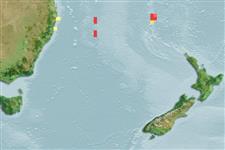>
Gobiiformes (Gobies) >
Gobiidae (Gobies) > Gobiinae
Etymology: Eviota: No etymology given, suggested by Christopher Scharpt: from Latin 'eu' for 'true' and 'iota' for anything very small, in combination 'truly very small' referring to it as being the smallest vertebrate at the time it has benn described by Jenkins (thus, making the suggestion by Scharpt plausible.; readerae: Named for Sally E. Reader..
More on authors: Gill & Jewett.
Environment: milieu / climate zone / depth range / distribution range
Écologie
marin récifal; profondeur 0 - 30 m (Ref. 59013). Temperate
Southwest Pacific, Middleton and Elizabeth Reefs on the Lord Howe Rise, Tasman Sea.
Taille / Poids / Âge
Maturity: Lm ? range ? - ? cm
Max length : 1.8 cm SL mâle / non sexé; (Ref. 59013)
Description synthétique
Morphologie | Morphométrie
Épines dorsales (Total): 7; Rayons mous dorsaux (Total): 9; Épines anales 1; Rayons mous anaux: 8; Vertèbres: 26. This species is distinct with the following set of characters: D VI + I, 9; A I, 8; with some pectoral-fin rays branched; fifth segmented pelvic-fin ray is lacking; cephalic sensory-pore system pattern 1; non-fimbriate male genital papilla; dark bars or saddles 12-13 on trunk from origin of spinous dorsal fin to mid peduncular spot, not extending below midline (except in small juveniles); pectoral-fin base with a prominent circular dark spot dorsally (sometimes with additional small diffuse spot ventrally) (Ref. 59013). Dorsal to anal fin-ray formula 9/8 (Ref. 116739).
Specimens were collected from tidal pools, lagoon patch reefs and reef slopes at depths from about 0.3 to at least 30 m (Ref. 59013). Benthic, also found in coral and rock reefs (Ref. 75154).
Life cycle and mating behavior
Maturité | Reproduction | Frai | Œufs | Fécondité | Larves
Gill, A.C. and S.L. Jewett, 2004. Eviota hoesei and E. readerae, new species of fish from the Southwest Pacific, with comments on the identity of E. corneliae Fricke (Perciformes: Gobiidae). Rec. Western Aust. Mus. 56:235-240. (Ref. 59013)
Statut dans la liste rouge de l'IUCN (Ref. 130435)
Menace pour l'homme
Harmless
Utilisations par l'homme
Plus d'informations
PaysZones FAOÉcosystèmesOccurrencesIntroductionsStocksÉcologieRégime alimentaireÉléments du régime alimentaireConsommation alimentaireRation
Noms communsSynonymesMétabolismePrédateursÉcotoxicologieReproductionMaturitéFraiRassemblement de ponteFéconditéŒufsDéveloppement de l'œuf
Taille/ÂgeCroissanceLongueur-poidsLongueur-longueurFréquences de longueursMorphométrieMorphologieLarvesDynamique des populations larvairesRecrutementAbondanceBRUVS
RéférencesAquacultureProfil d'aquacultureSouchesGénétiqueElectrophoresesHéritabilitéPathologiesTraitementNutrientsMass conversion
CollaborateursImagesStamps, Coins Misc.SonsCiguateraVitesseType de nageSurface branchialeOtolithesCerveauxVision
Outils
Articles particuliers
Télécharger en XML
Sources Internet
Estimates based on models
Preferred temperature (Ref.
123201): 21 - 22.9, mean 21.6 °C (based on 15 cells).
Phylogenetic diversity index (Ref.
82804): PD
50 = 0.5000 [Uniqueness, from 0.5 = low to 2.0 = high].
Bayesian length-weight: a=0.01023 (0.00477 - 0.02194), b=3.02 (2.84 - 3.20), in cm total length, based on LWR estimates for this (Sub)family-body shape (Ref.
93245).
Niveau trophique (Ref.
69278): 3.0 ±0.3 se; based on size and trophs of closest relatives
Résilience (Ref.
120179): Haut, temps minimum de doublement de population inférieur à 15 mois (Preliminary K or Fecundity.).
Fishing Vulnerability (Ref.
59153): Low vulnerability (10 of 100).
Nutrients (Ref.
124155): Calcium = 158 [58, 726] mg/100g; Iron = 0.781 [0.259, 2.074] mg/100g; Protein = 18.2 [15.8, 20.3] %; Omega3 = 0.433 [0.105, 1.832] g/100g; Selenium = 8.29 [1.82, 33.67] μg/100g; VitaminA = 65.8 [7.9, 530.2] μg/100g; Zinc = 2.88 [1.29, 5.71] mg/100g (wet weight);
